Table of Contents
Veins
Veins are Blood Vessels that collect oxygen-poor Blood and transport it back to Heart. They are a crucial component of the circulatory system and work in conjunction with other Blood Vessels and heart to maintain Blood circulation. Veins hold the majority of the Blood in the body with approximately 75% of it located in Veins.
What Are Veins Made of?
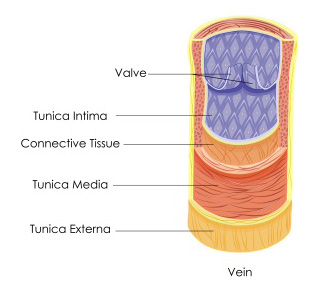
Veins are made up of three layers of tissues and fibers
- The Tunica Adventitia (outer layer)
- The Tunica Media (middle layer)
- The Tunica Intima (inner layer)
The Tunica Adventitia gives structure and shape to the Vein, while the Tunica Media contains smooth muscle cells that allow the Vein to widen or narrow as Blood passes through. The Tunica Intima has a lining of smooth endothelial cells that allows Blood to move easily through the Vein. Veins also contain one-way valves that keep Blood flowing in the right direction.
Blood Carried by Veins
Arteries and Veins differ in the type of Blood they transport. Arteries carry oxygen-rich Blood while Veins transport oxygen-poor Blood.
There is an exception to this rule. Pulmonary Veins – Veins situated between heart and lungs transport oxygen-rich Blood from lungs back to heart. Heart then pumps this oxygen-rich Blood to the rest of the body.
The purpose of each Vein depends on its location in the body. Veins are organized into a complex network called the Venous System.
Also Check – Main Types of Veins and their Functions
The Venous System and Circuits
The Venous System is the network of Veins in the body and the way they connect with other Blood Vessels and organs.
The Venous System has two main circuits –
- The Systemic Circuit
- The Pulmonary Circuit
Each circuit relies on Blood Vessels (Veins, Arteries and Capillaries) to maintain Blood flow.
To understand how these circuits function, think of a race track. The race cars must complete many laps around the course (circuit), but they cannot continue without refueling and quick tune-ups. Similarly, Blood cannot continue flowing throughout the body without refueling with oxygen and disposing of waste products like carbon dioxide.
Blood completes laps throughout the body on two different circuits every minute of the day. The systemic circuit runs through the entire body, including arms and legs. Oxygenated Blood leaves the heart and enters Arteries.
The Arteries branch off into smaller vessels called arterioles and then Capillaries, where Blood feeds the body’s tissues with oxygen and picks up waste products like carbon dioxide. Blood then enters venules before joining up with Veins, which transport the Blood back to heart where it can refuel. This oxygen-poor Blood enters the heart through two large Veins called the superior vena cava and inferior vena cava.
Once the Blood returns to heart, it completes the Pulmonary circuit. In this circuit, Blood travels to lungs where it refuels with oxygen before returning to heart through Pulmonary Veins. This is the only time when Veins carry oxygen-rich Blood. The Heart then pumps out this oxygen-rich Blood, beginning a new lap on the Systemic Circuit.
Also Check – Why is it necessary to separate Oxygenated and Deoxygenated Blood
What Makes Blood Flow in the Veins?
Veins require an external force to help push Blood in the right direction. Breathing and muscle movement, especially in the legs, are two significant forces. As the lungs expand and the diaphragm moves, it creates a suction force that helps Veins push oxygen-poor Blood toward the heart. Leg muscles play a vital role in helping Blood defy gravity and move upward from the feet and legs back to the heart.
The lower leg muscles act as a powerful pump that squeezes the deep Veins in the lower legs, known as the “second heart.” Each time you take a step, body weight squeezes the deep Veins in foot, pushing the Blood upwards. When you lift a heel, calf muscles squeeze the deep Veins in the calf and the Blood keeps moving up toward thighs and beyond. The pumping pace of the second heart adjusts to the speed of leg movement. The second heart only starts pumping when legs move and it allows Blood to keep flowing and complete its circuits through the body. This allows organs and tissues to receive oxygen and nutrients to function at their best.
Venules – Function and Characteristics
- Venules are small Blood Vessels that connect Capillaries with Veins throughout the body.
- They play a vital role in transporting Blood that contains waste and lacks oxygen from Capillaries to Veins, which then transport it back to the heart.
- Venules are wider than Capillaries but narrower than Veins and their size varies.
- Even the widest venule is approximately 16 times smaller than a typical Vein.
Also Check – 8 Structural and Functional Difference Between Arteries Veins and Capillaries
Functions of Veins
Veins have two primary functions. –
- Firstly, they collect oxygen-poor Blood from all over the body and transport it back to the heart.
- Secondly, they transport oxygen-rich Blood from lungs to the heart. This is the only time that Veins carry oxygen-rich Blood.
What Color Are Veins? – Veins are not actually blue despite what people might think. The Blood in Veins is dark red, darker than the Blood in Arteries which is cherry red. The blue appearance of Veins is a trick of the light as a result of the way light rays are absorbed into the skin. Blood is always red both in Veins and Arteries.
Why Do Veins Have Valves?
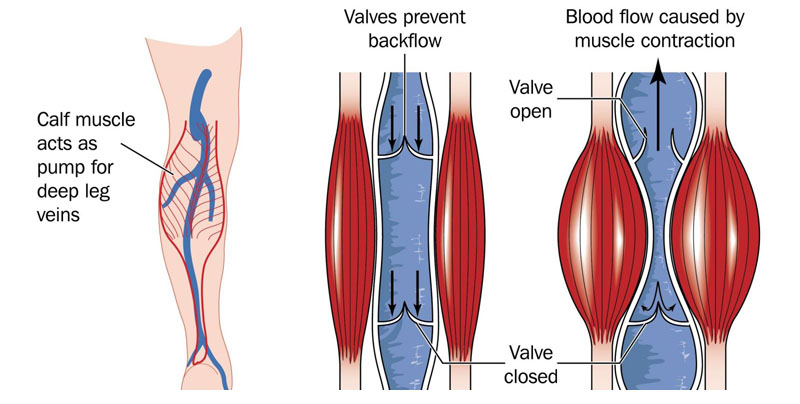
Veins have valves because they are responsible for carrying blood from different parts of the body back to the heart. Unlike arteries which have thick walls and can pump blood under high pressure. Veins have thinner walls and rely on the contraction of surrounding muscles and the presence of valves to move blood back to the heart.
Veins have valves to prevent the backward flow of blood and help move blood back to the heart. Valves work in conjunction with muscle contraction to help maintain healthy blood flow in the body’s Circulatory System.
Here are some key facts to help explain why veins have valves –
- The Purpose of Veins – Veins are blood vessels that carry deoxygenated blood from the body’s organs and tissues back to the heart where it can be reoxygenated and pumped back out to the body. Veins are responsible for returning the blood that has been used by the body’s cells and tissues back to the heart.
- The function of Valves – Valves are structures that prevent the backward flow of blood in the Veins. They work by opening and closing in response to the pressure of Blood flow. As Blood moves through a Vein, the valve opens to allow blood to flow forward and then closes to prevent blood from flowing backward.
- The Anatomy of Veins – Veins have thinner walls than Arteries and are often located closer to the skin’s surface. They also have less muscle tissue and are less elastic than Arteries. These differences make veins more susceptible to the effects of gravity and less able to pump blood under high pressure.
- The role of Muscle Contraction – Veins rely on the contraction of surrounding muscles to help move blood back to the Heart. This is why exercise and physical activity can be beneficial for vein health. When muscles contract, they compress the veins and help push blood towards the Heart.
- The impact of Valve Dysfunction – If the valves in the veins don’t function properly, blood can flow backward and pool in the veins. This can lead to a variety of conditions, including varicose veins, deep vein thrombosis (DVT) and chronic venous insufficiency (CVI).
Also Check – 15 Important Differences Between Arteries and Veins
Function of Vein Valves
One-way valves in Veins are located approximately one inch apart and allow Blood to flow only towards the heart. These valves are bicuspid, consisting of two flap-like structures made of elastic tissue. The main function of these valves is to ensure that Blood flows in one direction, preventing the backward flow of Blood back down the legs. When the leg muscles contract, Blood is squeezed upwards through the Vein and the valves open to allow it to circulate successfully. Once the Blood has passed the valve, it continues up through the leg, moving past each valve with every muscle pump of the leg. When the leg muscles relax, the valves in the Veins close, preventing the backward flow of Blood.
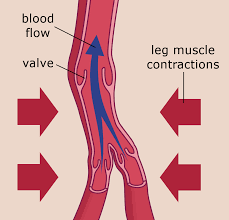
Open Vein Valves
As the leg muscles contract, the Blood within the deep Veins is squeezed upward through the Vein, prompting the initial opening of the valve. The contraction propels the Blood through the Vein and as it passes the valve, the valve opens, allowing Blood to flow towards the heart. This process continues with every muscle pump of the leg.
Closed Vein Valves
When the leg muscles are at rest, the Vein valves close. As long as the valves are working properly, the closing of the valves will prevent Blood from flowing backward and pooling within the legs. Leg movement that prompts Blood flow is referred to as a muscle pump.
Types of Veins in the Legs
The legs contain three types of veins
- Superficial Veins
- Deep Veins
- Perforator Veins.
Each type of vein plays a specific role in the circulatory system of the legs. Detailed explanation of each type of vein –
Superficial Veins
These veins are located close to the surface of the skin and are visible from the outside. They are responsible for draining blood from the skin and subcutaneous tissues of the legs. The two main superficial veins in the legs are the great saphenous vein (GSV) and the small saphenous vein (SSV). The GSV runs from the inside of the ankle to the groin, while the SSV runs from the outside of the ankle to the back of the knee. These veins can become enlarged and twisted, leading to varicose veins.
Deep Veins
These veins are located deep within the muscles of the legs and are responsible for carrying the majority of the blood back to the heart. They run alongside the major arteries and are surrounded by muscle tissue, which helps to pump blood back to the heart. The two main deep veins in the legs are the femoral vein and the popliteal vein. These veins can become blocked, leading to a condition known as deep vein thrombosis (DVT).
Perforator Veins
These veins connect the superficial veins to the deep veins and allow blood to flow between the two. They are located throughout the leg and are responsible for directing blood from the superficial veins to the deep veins. These veins can become damaged or blocked leading to a condition known as perforator vein insufficiency.
Frequently asked question on Veins
What are the three layers that make up veins?
What is the difference between arteries and veins in terms of the type of blood they transport?
What is the purpose of the venous system?
What are the two main circuits of the venous system?
How does the body push blood in the right direction in veins?
What is the role of venules in the circulatory system?
What are the two primary functions of veins?
Why do veins have valves?
Why are veins not actually blue?
What is the role of the second heart in the circulation of blood in the legs?
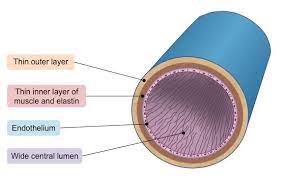
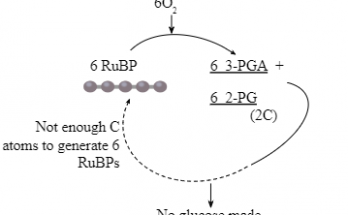
6 Comments on “Veins – Structure , functions ,Venous System and Circuits and Vein Valves ”